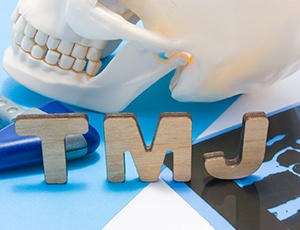TMJ Treatment – Carrollton, TX
Dental Solutions for Chronic Jaw Pain

You may already know to call your dentist when you’re having problems with your teeth, but what about issues with your jaw? If you’re currently dealing with jaw pain on a regular basis, you may have what is known as a TMJ disorder – and a dentist like Dr. Azmoodeh may have the answer for treating it. Do you want to find out more about TMJ disorder and how it can be dealt with? Get in touch with our team today.
Why Choose Epic Family Dentistry of Carrollton for TMJ Treatment?
- Expertly Designed High-Quality Occlusal Splints
- Caring, Knowledgeable Dental Expert
- Late and Saturday Appointments Available
What is TMJ Disorder?

Have you ever thought about the hinges that keep your lower jaw connected to the rest of your skull? They’re known as the temporomandibular joints, or TMJs for short. As long as your TMJs are functioning properly, you will have no trouble when it comes to eating, speaking, or performing other everyday oral tasks.
However, sometimes problems can arise with the TMJs. They might become injured after you get hit in the face, or they could become overworked due to bite problems. These types of issues are known as TMJ disorders, and trying to live with them can be very painful.
Symptoms of TMJ Disorder

The exact symptoms associated with TMJ disorder can vary from case to case depending on what the underlying cause is. In addition to pain in your jaw joint, you might also suffer from migraines as well as pain in your back or neck. You may notice a clicking sound when you move your mouth, and your jaw mobility might be limited. Sometimes your jaw might even get locked, preventing you from opening or closing it.
Types of TMJ Treatment

When you notice the warning signs of a TMJ disorder, you can schedule an appointment at our office. We can examine your jaw and take a number of X-rays in order to figure out where the problem lies. Once we have confirmed that you have a TMJ disorder and have narrowed down the underlying cause, we’ll work with you to figure out what kind of treatment would be appropriate.
Occlusal Splint
Oftentimes, a TMJ disorder can be treated with an appliance known as an occlusal splint. You can think of it as a special kind of mouthguard. Your splint will be customized for your unique smile, and we will give you instructions regarding how often you should wear it.
An occlusal splint can help reposition the lower jaw, bringing it slightly forward. This can move the jaw joints toward a more comfortable resting position. Additionally, occlusal splints can potentially be used to stop the upper and lower rows of teeth from grinding against each other. This can go a long way toward helping you find relief since teeth grinding can often play a role in TMJ disorder.
TMJ Treatment FAQs
Is TMJ Treatment Safe?
Generally speaking, yes, TMJ treatment is considered to be safe. This is especially true if you’re pursuing minimally invasive methods; while you can potentially undergo surgery for TMJ disorder, it’s better to try more conservative treatments first since there are fewer risks involved. Occlusal splints in particular are considered a very safe way to reduce TMJ-related symptoms. If you have any concerns about your treatment, don’t hesitate to let us know.
How Long Does TMJ Treatment Take?
Some cases of TMJ disorder are more severe than others, so the exact amount of time that it takes for you to find relief from your pain depends on your unique circumstances. When it comes to occlusal splint therapy, sometimes you’ll see results after wearing your splint every night for just a few weeks. In other cases, it may take several months of using the splint before you achieve the improvements that you want. Since occlusal splints address the underlying cause of your TMJ disorder, you can expect the relief to last for a long time – potentially for the rest of your life.
Is TMJ Treatment Covered by Insurance?
Some insurance companies won’t cover TMJ treatment at all if they’re not required to. Others might only be willing to help pay for specific types of treatment. You should reach out to your insurance provider to see what coverage is available regarding TMJ-related procedures.
It should be noted that since the TMJ is a joint, it is not considered to be specifically related to dental health. That being said, a number of TMJ treatments can only be performed by a dentist. As such, your treatment can sometimes be covered by dental insurance, but in other cases, regular medical insurance might be used instead.
Is TMJ Treatment Expensive?
The fact of the matter is that no two patients will pay exactly the same amount for TMJ treatment. The cost can be influenced by:
- The type of treatment that you receive.
- The cause and severity of your disorder.
- The specific provider that you visit and the geographic area that they’re located in.
When discussing your treatment options, we will give you an estimate of what the overall cost of your TMJ therapy will look like. On top of that, we will help you explore your options for making sure that you’re able to fit the cost of your treatment into your budget. For example, you can apply for CareCredit, which allows you to pay for your care in a series of installments instead of all at once.
How Do I Clean My TMJ Splint?
You should clean your occlusal splint every morning after you take it out of your mouth. Brush every surface of the splint gently with a soft-bristled toothbrush and anti-bacterial hand soap. Once you’re done brushing, rinse the splint off thoroughly before storing it in its case. It’s also recommended that you periodically soak your splint in a cleaning solution; this should help get rid of unpleasant odors and stains.
